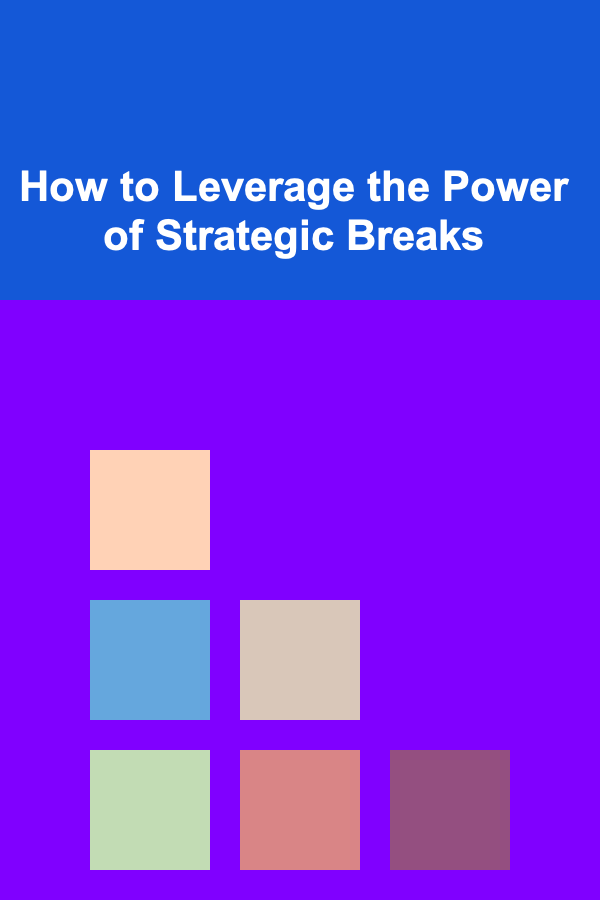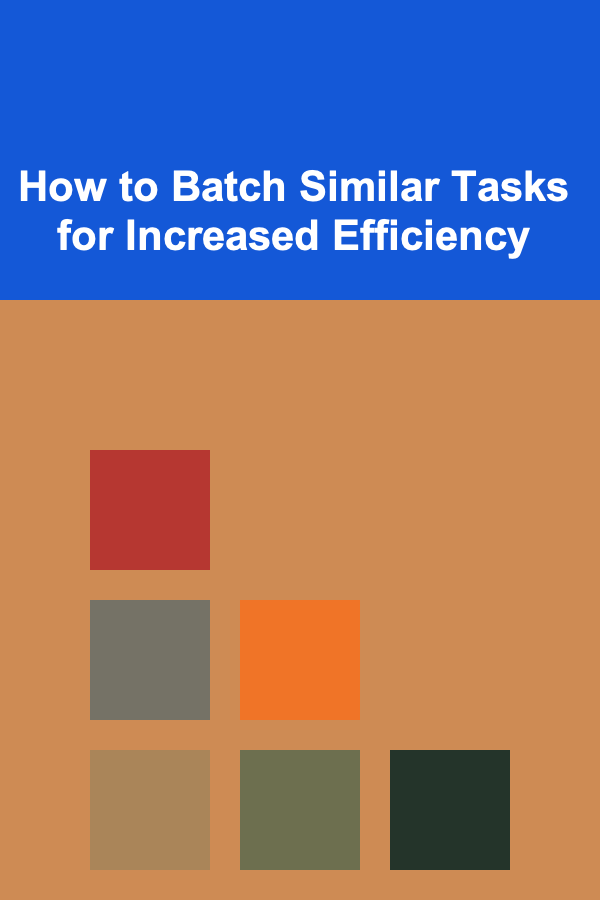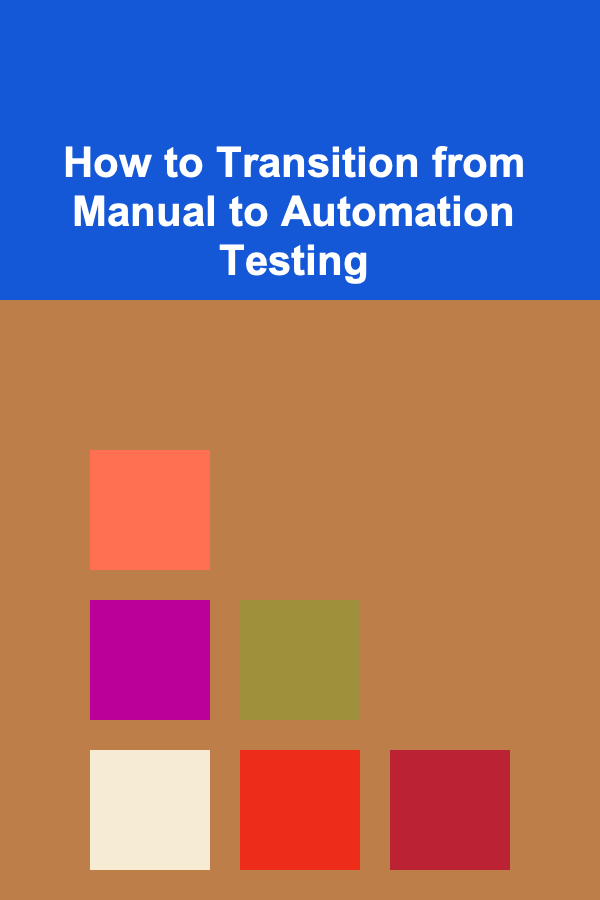
How to Leverage the Power of Strategic Breaks
ebook include PDF & Audio bundle (Micro Guide)
$12.99$10.99
Limited Time Offer! Order within the next:

In today's fast-paced world, the pressure to maintain continuous productivity often leads to burnout, stress, and a decline in overall performance. We are often told to "keep pushing through" and "work harder," but this approach is not sustainable in the long run. One crucial element to achieving sustained productivity, creativity, and well-being is the power of strategic breaks. These breaks are not just about taking a moment to step away from the desk, but about using that time to recharge, refocus, and ultimately enhance performance.
This article explores the importance of strategic breaks, the science behind them, and practical strategies for integrating them into your daily routine to achieve both short-term and long-term success.
The Science Behind Breaks
At the core of understanding strategic breaks lies the science of how our brains work. When we engage in mental tasks, we draw on cognitive resources like attention, memory, and problem-solving skills. However, these resources are limited and can become depleted over time, leading to mental fatigue and diminishing returns on our efforts. This is known as cognitive load.
Our brains were not designed to work non-stop for long periods of time. Research has shown that when we take breaks, we allow our cognitive resources to replenish, which leads to greater focus, higher productivity, and better decision-making. One key study conducted by the University of Illinois found that individuals who took short, regular breaks during tasks performed better and felt less mentally fatigued compared to those who worked non-stop.
In addition to replenishing cognitive resources, taking breaks also allows our brains to enter a state of relaxation, which can encourage creativity and problem-solving. Often, the best ideas and insights emerge not during intense work sessions, but after stepping away from the task at hand and allowing the mind to wander.
The Benefits of Taking Strategic Breaks
Understanding the benefits of strategic breaks is key to leveraging their power. Here are some of the most notable advantages:
1. Increased Productivity
It may seem counterintuitive at first, but taking breaks can actually lead to higher productivity in the long run. The Pomodoro Technique, for instance, involves working in blocks of time (usually 25 minutes) followed by a short break (usually 5 minutes). After four work sessions, you take a longer break (15--30 minutes). This method ensures that you are consistently focused during your work periods while also giving your brain the necessary downtime to refresh and reset.
Research supports this method: Studies have shown that taking short, frequent breaks improves attention, helps sustain focus, and prevents burnout. When you take breaks, you come back to tasks with a clearer mind, allowing you to accomplish more in less time.
2. Improved Mental Health
Continuous work without breaks is closely linked to increased stress and anxiety. In contrast, strategic breaks have been shown to reduce feelings of stress and improve overall mental health. By stepping away from demanding tasks, you give your brain a chance to process information, recalibrate, and prevent emotional overload.
When you take breaks, you also activate the parasympathetic nervous system, which promotes relaxation and helps reduce the body's physical stress response. Over time, incorporating breaks into your routine can lower your risk of burnout and mental fatigue.
3. Enhanced Creativity
One of the most overlooked benefits of taking breaks is the boost to creativity. When we are immersed in a task for an extended period, we become trapped in our mental patterns, often limiting our ability to think outside the box. A well-timed break, especially one that involves physical movement or a change of environment, can lead to fresh perspectives and new ideas.
In fact, many successful innovators, such as Steve Jobs, have spoken about the value of walking breaks to spark creativity. Stepping away from a problem can allow the subconscious mind to continue working on it, often leading to breakthroughs when you return to the task.
4. Physical Health Benefits
Sitting for long hours, especially when working at a computer, has been linked to various health issues, including obesity, cardiovascular disease, and musculoskeletal problems. Taking regular breaks, particularly those involving physical movement, can help reduce the negative impacts of sedentary work.
A study by the Mayo Clinic found that standing up and moving for just a few minutes every hour can reduce the risk of health issues associated with prolonged sitting. Activities such as stretching, walking, or even light exercises during breaks can help maintain overall physical health and energy levels.
Types of Strategic Breaks
Not all breaks are created equal. The way you take a break, the type of break you choose, and the duration of your break all play a role in its effectiveness. There are different types of breaks that you can incorporate into your routine, depending on your needs and goals.
1. Micro Breaks
Micro breaks are brief pauses---typically lasting 1 to 5 minutes---taken throughout the day. These breaks are particularly helpful for maintaining focus and preventing mental fatigue. Micro breaks can involve stretching, deep breathing exercises, or simply standing up and walking around for a few minutes.
Though short, micro breaks can significantly improve cognitive function and reduce physical strain. The key is to make them regular and consistent throughout your workday. Studies have shown that taking these brief pauses every 30--60 minutes can keep your brain sharp and help prevent mental burnout.
2. Active Breaks
Active breaks involve physical movement, such as stretching, walking, or doing light exercises. These breaks are particularly effective for those who work in sedentary environments, as they help reduce physical tension and improve circulation.
Taking an active break during your workday can also boost your energy levels and improve mood. For instance, going for a brisk walk or doing a few stretches can increase the release of endorphins, the body's natural mood elevators.
3. Mindful Breaks
Mindful breaks focus on mental relaxation and rejuvenation. Activities like meditation, deep breathing, or simply closing your eyes and focusing on your breath can help clear your mind and reset your focus. Mindfulness practices have been shown to reduce stress, improve emotional regulation, and enhance overall well-being.
A mindful break allows you to detach from work temporarily and create space for reflection and relaxation. Taking 5--10 minutes to meditate or practice deep breathing can significantly improve your concentration and emotional state.
4. Creative Breaks
Creative breaks are designed to foster inspiration and creativity. These breaks involve engaging in activities that stimulate the mind in different ways, such as drawing, writing, listening to music, or engaging in a hobby. Creative breaks can be especially beneficial when you're feeling stuck on a task or problem.
These breaks allow the brain to process information unconsciously, often leading to new ideas or solutions when you return to the task. Whether it's a quick doodle or a few minutes of journaling, creative breaks are an excellent way to recharge your mind and spark innovation.
5. Longer Breaks (Restorative Breaks)
While micro and active breaks can be effective throughout the day, longer breaks are necessary for deeper rest and recovery. These breaks may range from a 30-minute lunch break to a full day off. Longer breaks provide the time needed for significant physical and mental restoration, allowing you to return to work with renewed focus and energy.
Taking a lunch break away from your workspace can help you avoid the trap of mindless snacking and give your body and mind a chance to truly relax. Similarly, scheduling regular days off or vacations is essential for long-term well-being and preventing burnout.
Best Practices for Implementing Strategic Breaks
Incorporating strategic breaks into your routine requires planning and intention. Here are some best practices for making the most of your breaks:
1. Schedule Your Breaks
One of the most important steps in ensuring that you take breaks is scheduling them. It's easy to get caught up in the work and skip breaks, but this will eventually lead to fatigue. Schedule your breaks ahead of time to ensure that they become a consistent part of your day.
Use tools like calendar reminders or productivity apps to prompt you to take breaks at the appropriate times. For example, you can set a reminder to take a 5-minute break every 25 minutes of focused work, or you can plan a 30-minute lunch break each day.
2. Set a Purpose for Each Break
Not all breaks should be the same. Each break you take should have a clear purpose to maximize its effectiveness. For example, a micro break might focus on relaxation, while an active break could include stretching or walking. A creative break might involve reading or sketching, and a mindful break could be dedicated to meditation.
By setting a purpose for each break, you ensure that it serves a specific need, whether it's mental relaxation, physical movement, or creativity.
3. Embrace the Power of Disconnection
During breaks, it's crucial to disconnect from work entirely. This means avoiding checking emails, social media, or doing anything work-related. Allow yourself to truly unwind and recharge during your break. This disconnection helps reset your mind and makes it easier to return to work with full attention and energy.
4. Incorporate Nature
Whenever possible, try to take your breaks outdoors. Nature has been shown to have a calming effect on the mind and body, reducing stress and improving mood. Even a short walk in a park or just sitting outside can help reset your brain and boost creativity.
5. Use Technology Wisely
While technology can be distracting, it can also support your break-taking routine. There are numerous apps designed to encourage taking breaks, such as the Pomodoro timer or apps that remind you to stand up and move. Use technology as a tool to keep you on track with your breaks.
Conclusion
Incorporating strategic breaks into your daily routine is essential for maintaining productivity, mental health, and creativity. By understanding the science behind breaks and utilizing various types of breaks---whether micro, active, mindful, or creative---you can boost your overall performance, reduce stress, and avoid burnout.
The key is to prioritize rest and recovery as much as work. When done strategically, breaks become not just a way to recharge, but a powerful tool for enhancing your overall work performance and well-being. So, take a step back, breathe, and embrace the power of breaks for a more productive and fulfilling life.
Reading More From Our Other Websites
- [Home Soundproofing 101] How to Block Out Noises from the Outside with Simple Techniques
- [Home Security 101] How to Secure a Home with a Pool: Essential Tips for Pool Safety
- [Home Family Activity 101] How to Create a Family "Bucket List"
- [Home Cleaning 101] How to Establish an Effective Bathroom Cleaning Routine for a Hygienic Home
- [Organization Tip 101] How to Make Use of Under-Bed Storage for Pet Supplies
- [Rock Climbing Tip 101] How to Set Up a Self‑Rescue System on Single‑Pitch Trad Routes
- [Home Staging 101] How to Stage a Small Apartment to Look Bigger
- [Personal Care Tips 101] How to Use a Toothbrush to Clean Your Tongue and Improve Freshness
- [Whitewater Rafting Tip 101] Paddles, Power, and Purpose: Turning Rafting Adventures into a Blueprint for a New Life
- [Home Maintenance 101] How to Ensure Your Home's Plumbing is Winter-Ready

How to Batch Similar Tasks for Increased Efficiency
Read More
How to Create an Effective Employee Onboarding Checklist
Read More
How to Maintain Open Communication with Your Partner During Planning
Read More
How to Organize Family Travel Essentials for Smooth Trips
Read More
How to Use Sewing/Tailoring to Make Money
Read More
How to Transition from Manual to Automation Testing
Read MoreOther Products

How to Batch Similar Tasks for Increased Efficiency
Read More
How to Create an Effective Employee Onboarding Checklist
Read More
How to Maintain Open Communication with Your Partner During Planning
Read More
How to Organize Family Travel Essentials for Smooth Trips
Read More
How to Use Sewing/Tailoring to Make Money
Read More